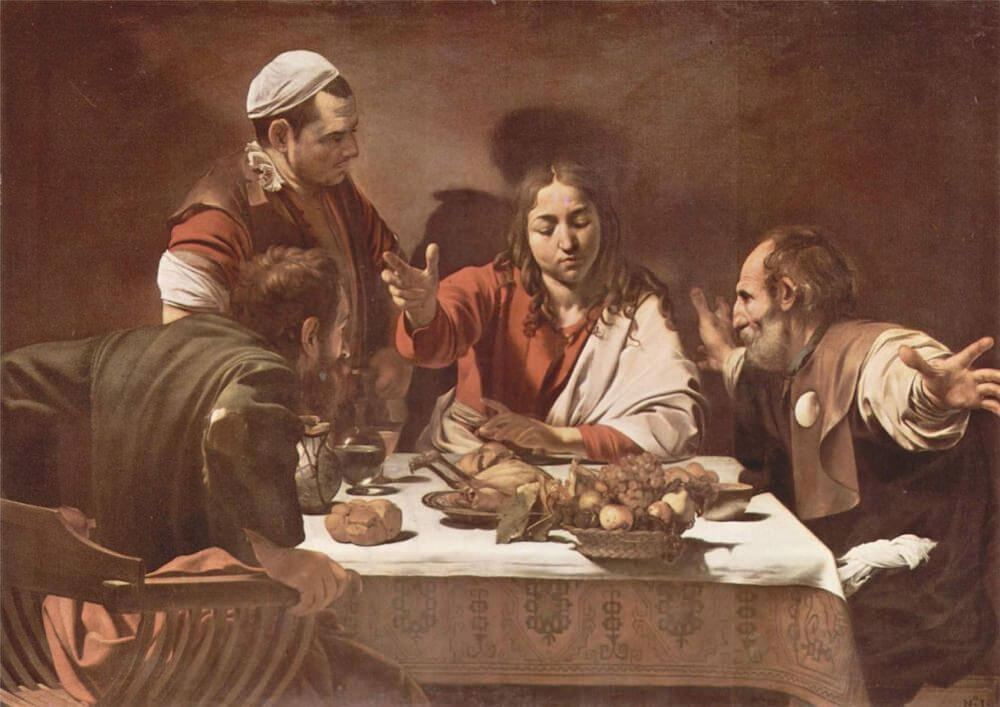Sermon preached at St. Augustine’s Episcopal (Zoom) Church
26 April 2020 Easter 3A: Acts 2:14a,36-41 & Luke 24:13-35
I want to start my reflection here with an observation:
Today’s readings show us two pretty different ways of telling the resurrection story.
In Acts, Peter is all confidence. He gives this powerful speech. Full of conviction, and with the dots all connected. In fact, we’re spared most of it, as our reading skipped from verse 14 where he starts, all the way to verse 36—the last sentence of the speech! People respond by throwing themselves at his feet for baptism. 3,000 of them, it says, were baptized in one day.
Then there’s the Luke version of the resurrection story. (Actually, it’s the same author!) It’s the story as it’s still being written.
The disciples had witnessed a traumatic event. But first, they’d had the chance to fall in love—or at least to fall into hope —with Jesus. It’s not clear how long they had been following him. But I imagine they were at least there for the palm procession a week ago. The supper on Thursday where he fed them, and then washed their feet, and told them he loved them. Maybe they were there in the Garden of Gethsemane too. Then Friday they watched him die. But it wasn’t just any death—it was an execution.
It was torture. Suffocation. Humiliation.
The disciples were disappointed. They were terrified. Quite naturally, they went into hiding. Then some women broke the quarantine with their burial spices…and they came back with this story of an empty tomb, and angels.
It was just too much for these Cleopas and his partner—so they skipped town, taking only their trauma and grief with them.
I don’t know if they actually decided to leave town; maybe they just went for a walk and kept going. But there they were, almost to Emmaus, seven miles from Jerusalem.
And as they walk, they talk. They process not only the facts—how “he was a prophet mighty in deed…and they crucified him.” But they talk about the emotions attached to them too— “But we had hoped he was the one to redeem Israel….”
The Acts story, & the Luke passage: Two accounts. Both true. The big difference, it seems to me, is that in the Acts, Jesus clearly had been resurrected . (Past tense.) But in Luke, although Jesus IS risen, what it all means hasn’t quite taken hold yet.
The gospel story feels more reflective, to me, of this moment in our lives. I find it a more helpful account, as we struggle to know what it means to live as Easter people right now: now, in the 3rd week of Easter; and now, in our 6th week of staying-at-home to flatten-the-curve…having just learned we have (at least) 5 more to go here in Illinois.
The Rev. Dr. Matt Skinner, reflecting on our pandemic Easter season, wrote this: “[After] the desolation of Holy Week, the confident Easter refrains of joy, triumph,…belonging, and commission usually lead us to assume that resurrection means the end of disappointment. Everyone’s supposed to smile and shout, “He is risen indeed.” But Easter faith can be both a
resurrection hope, AND a lamenting restlessness, at the same time.” (https://www.workingpreacher.org/craft.aspx?m=4377&post=5428)
I am grateful for this reminder that there’s space enough in this season for both: Space enough for both clear-eyed resurrection hope…and also, for restless lament. Easter is big enough to hold them both. And this comes as good news to my ears, because frankly, we have much to lament and be
restless about right now.
I lament for our sick neighbors, and for the healthcare workers caring
for them. I lament for those most hurt by this isolation. I am restless to hug my friends again. To worship in person with you again–to place bread in your hands, “the Body of Christ.” Restless for schools and parks to open back up. I lament the ugly facts we can’t run away from: how COVID hits communities of color so much harder than whites;2 how low-wage workers face the most dire economic consequences and choices. (See https://www.theatlantic.com/ideas/archive/2020/04/coronavirus-exposing-our-racial-divides/609526/.)
I wonder what you would add to this list?
Indeed, we have much to be restless about right now. And so I am drawn to the part of this story where the very process of restless lament itself helps form these two disciples into the Easter people they are becoming.
It all starts with that moment on the road when Jesus comes alongside them and asks what they are talking about.
Their response is less than gracious—which I suspect comes from a place of woundedness: “Are you the only stranger in Jerusalem who doesn’t know about the things?!”
And Jesus asks, “what things?” Notice how he does not answer, yes or no to their question. He just responds with an invitation to share more: “What things?”
And they respond…by pouring their hearts out to him. They share the facts; and they share their raw emotions about the facts: “ But we had hoped that he was the one to redeem us…!”
And now that they’ve opened their hearts to him, he responds by opening the scriptures to them, albeit with a wounded tinge of his own: “Oh how foolish you are, and how slow of heart to believe…!” Then he goes on to reveal so much to them, right there on the road.
And then there comes, what for my money, is the dramatic high point of the story. “As they came near the village to which they were going, he walked ahead as if he were going on. But they urged him strongly, saying ‘stay with us!’ Even though, just a few miles back, he had called them ‘foolish, and slow of heart’. Something about their time with him compels them to want him to stay.
And so he stays with them. And because he stays, they have dinner together
Where Jesus takes bread; blesses it; breaks it; and gives it to them.
And it is in this breaking and sharing that they come to recognize him.
In his message to the diocese this week , Bishop Jeffrey Lee noted that the story doesn’t actually say whether the disciples ate the bread Jesus gave them. (See https://www.youtube.com/watch?v=bAoS3AgI3BQ&feature=youtu.be (~4:00 in).)
This came as a surprising bit of good news to me, as our collective fast from Eucharist continues. Good news because it reminds me that even though we cannot share the sacrament in person right now, we can still be transformed by it. We know what it feels like to gather around the table.
We recognize it in the taste of bread and wine. We remember that we are sent forth from it—a people forgiven, healed, renewed! It is familiar enough to us—deep enough in our bones—that even in its absence, we can still be
transformed by it!
We don’t know if the two disciples ate the bread or not. (I, for one, never pass up an offer of bread…but I wasn’t there.) What we do know—what Luke does tell us—is that they got up immediately and ran the seven miles back to Jerusalem.
Suddenly, they wanted back into the quarantine space, so they could tell the others what had happened to them on the road. Suddenly their Easter faith is overflowing with both restlessness AND hope! Suddenly things would never be the same again (if there ever really was a ‘same’ to begin with).
So much remains unresolved at the end of this story. That’s another way it resonates for me with our current moment. It’s a big ol’ cliffhanger. What will Jesus do next? What will the Roman authorities do? Where will everyone sleep? (Seriously, thirteen people locked in one Upper Room overnight?!)
For them and for us, the big question: How is discipleship going to look now? Jesus is risen, but the fear still lingers. The vulnerability remains. Even the wounds still remain.
Yet there it is: space for resurrection hope—right alongside our restlessness.
Thanks be to God!
The Rev. Nadia Stefko is rector of St. Augustine’s Episcopal Church in Wilmette, IL. She is a graduate of the University of Notre Dame and the Divinity School of the University of Chicago (MDiv). She is married to Steve Thorngate and they have two daughters. Nadia describes herself as “a recovering organic farmer.” She wrote an article on “Sabbath Nourishment” published in the September 27, 2017 issue of Living Lutheran. https://www.livinglutheran.org/2017/09/sabbath-nourishment/


